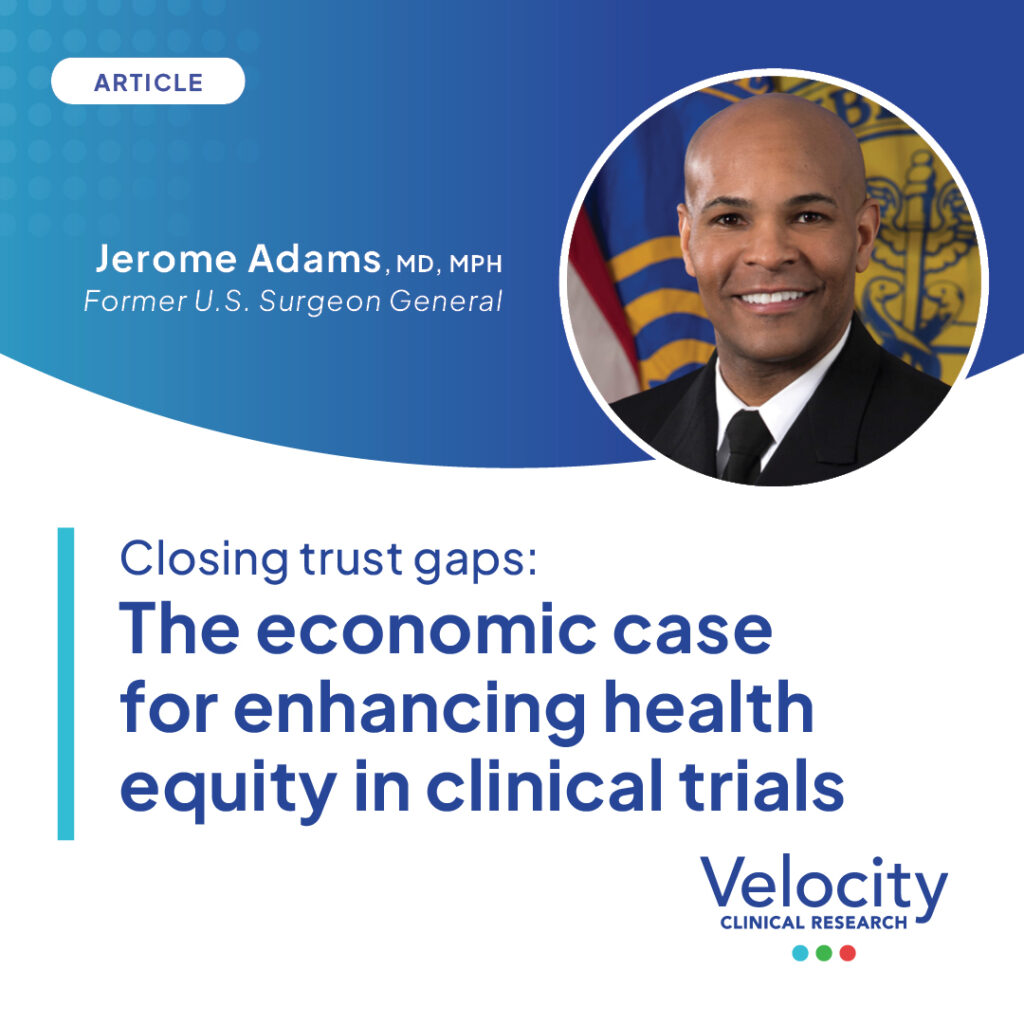The pandemic left many notable developments in its wake, not least the increased focus on improving diversity in clinical trials. This issue was thrust into the spotlight during Operation Warp Speed — the accelerated development of a COVID-19 vaccine in the U.S. — and is one Jerome Adams, MD, MPH, who served as U.S. General Surgeon from 2017 to 2021, discussed in a recent seminar with the Velocity team.
Representation in vaccine trials
Under Operation Warp Speed, COVID-19 vaccine trial participants needed to represent the wider U.S. population, a choice that could have slowed down approval. Yet, the team saw it as an imperative; without representativeness, the government couldn’t guarantee the safety or efficacy of a vaccine in minority populations.
It’s a theme that carried beyond the pandemic, with the FDA issuing draft guidance in 2022 that aimed to ‘improve enrollment of participants from underrepresented racial and ethnic populations’. But, as Dr. Adams pointed out, that’s easier said than done.
“Part of health equity is understanding that not everyone needs the same thing,” he explained. “Understanding that we go into some of these communities operating from a trust deficit. We’re not starting at zero; we’re starting at less than zero.”
Trust deficit in marginalized communities
It’s a catch-22. Clinical trials need diversity to engender trust in the data collected, but a lack of confidence in public healthcare means minorities often don’t engage with clinical trials. This is a legacy left by historical inequality and segregation.
“There’s long been a philosophy in medicine that we experiment on marginalized populations, and we don’t think as much about the risk to those populations,” explained Dr. Adams. “Tuskegee is the example in America, but this is oftentimes a global phenomenon.”
The Tuskegee experiment was established in 1932 to investigate the progression of syphilis and recruited 600 African American men with the promise of free medical care. None of the participants were informed they were suffering from syphilis and were administered only placebos. The study was shut down in the 1970s, by which time 28 participants had died from syphilis, 100 had passed from related conditions, multiple spouses had been infected, as had 19 children.
Addressing the distrust caused by incidents like this is vital to ensuring health equity, a goal Dr. Adams passionately advocates for. He sees health equity as a world where everyone has a fair opportunity to make healthy choices and can be the happiest version of themselves.
The first step to achieving that is building bridges with the communities that have reason to distrust healthcare providers. “You have to start building trust in those communities,” he said. “You have to start doing that community outreach long before you want their blood or their data or for them to participate in a clinical trial, or they’re going to distrust you.”
Building trust to ensure health equity
It’s a future all healthcare providers have a duty to commit to; something authorities are increasingly recognizing with initiatives such as the FDA’s draft guidance on diversity plans to improve representation in clinical trials. As the leading integrated site organization, Velocity is committed to increasing diversity in clinical trials and has a team dedicated to building meaningful relationships with the communities around our 90 sites globally.
These teams work to engage with local communities via coalition groups, faith organizations, and hospital systems. The aim isn’t simply to be present but to take a meaningful role that delivers a positive impact, whether that’s through support, participation, or investment. This establishes trust between testing sites and the communities they serve while providing opportunities to build awareness of clinical trials, ensuring the community understands the benefit of the process.
Patients feel more secure with teams that understand their lived experiences, and representation is a core focus for the Velocity team globally. Our PAC (Participant Advisory Committee) initiative and VISION app are just two channels that provide safe spaces for patients to provide feedback; we use this data to inform staff training and ensure everyone has the tools to build and maintain an environment of psychological safety.
The benefits of increased diversity
The result is higher levels of diversity within clinical trials and the inclusion of patients who stand to benefit from the treatment once it’s approved. For the sponsor, this delivers more generalized results in clinical trials and a greater understanding of the effect of treatment in different demographics. For patients, it increases healthcare access and contributes to equity.
Challenging the idea that conformity within clinical trial patients is correct or even desirable is crucial if we’re to achieve health equity. Increasing representativeness improves patients’ access to healthcare and ensures that trial outcomes are well understood for people with obesity, chronic disease, or those from a minority background. As Dr. Adams pointed out during his seminar: diversity isn’t just a moral imperative; it’s good science.

